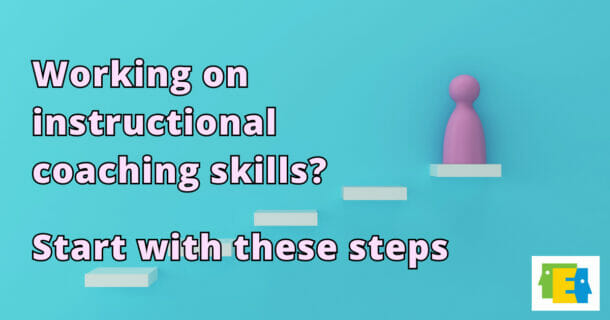Designing an Experiment to Work on Instructional Coaching Skills in 4 Steps

Designing an experiment is a strategic way to approach improving instructional coaching skills.
Whether you’re a teacher coach ready to jump into action or a school leader supporting coaches, it’s important to have a plan.
Instructional coaching expert Megan Tschannen-Moran, author of “Evocative Coaching”, recommends taking four steps before making a change in your instructional coaching practices.
You may be familiar with steps 1-3, but step 4 is the big one to pay attention to.
Listen to Megan Tschannen-Moran explain the experiment design process for instructional coaching skills in the video down below.
Continue reading to learn the steps for improving instructional coaching skills through an experiment design protocol.
Step 1: Articulate a hypothesis about your instructional coaching skill focus.
The experiment design process starts with creating a hypothesis about the instructional coaching skill a coach wants to work on.
Perhaps during coaching conversations, the coach is doing more of the talking than the teacher they are supporting. Active listening during coaching conversations could be the focus skill to strengthen instructional coaching.
Megan Tschannen-Moran gave this example of a hypothesis an instructional coach could articulate:
‘If I talk less, then the teacher is going to get more engaged in the coaching process.’
Stating a hypothesis is important to the experiment design process because it provides a clear, testable prediction of what an instructional coach thinks will happen if they work on a particular teacher coaching skill.
Having a specific skill (here, talking less during coaching conversations) named in the hypothesis also ensures the experiment is focused.
Instead of attempting to work on multiple instructional coaching skills at the same time, an instructional coach can work on the single identified skill with a predicted outcome in mind.
Step 2: Identify strategies to improve the identified instructional coaching skill.
Megan Tschannen-Moran suggested instructional coaches ask themselves, “How will I test that hypothesis? What are the strategies? What are the steps that I’m going to engage in?”
This means laying out a specific strategy to work on the skill a coach wants to improve.
For working on actively listening and talking less during coaching conversations, this could involve using something like a scripted template with selected teachers. Or, coaches may decide to videotape their coaching conversations to seek feedback.
Identifying a concrete strategy sets the course for action to take or steps to implement for improving.
Step 3: Determine what evidence will help assess the impact of instructional coaching changes.
“How will I know if I get better?” is an integral question in the experiment design process.
Before working on the strategy identified to improve an instructional coaching skill, it’s important to know how coaches and those supporting coaches’ development will assess if the strategy is working.
A coach should know what evidence they will collect (for example, counting the number of minutes they talked during a coaching conversation) to ensure they can measure if there has been an impact.
Check out this resource from Megan Tschannen-Moran’s Center for School Transformation to help measure talk time: Charting Talk Time
Step 4: Gut-check readiness to take action on instructional coaching goals.
Designing an experiment is not meaningful if there is no follow-through.
That’s why Megan suggests that coaches self-assess by asking, “How likely am I to implement this?”
On a scale of 1-10, coaches determine how likely it is they will implement the strategy to work on their identified instructional coaching skill.
We think this step is the true key for any coaches working on improving their instructional coaching skills.
Sure, there may be a plan for a coach’s improvement. But will it actually be implemented?
Without strong-enough confidence and readiness from a coach, a strategy might never even be tried.
Megan advised instructional coaches, “We want at least a seven out of 10 in confidence that ‘I think I can do this.’”
If a coach’s confidence level is less than seven, it can be helpful for them to think about why that number wasn’t even lower – highlighting how much confidence and capability they do have.
Coaches and those supporting them can also consider, “What would it take to get it up to a seven?” Maybe there’s an obstacle that a peer coach can help address or resources needed.
Identifying the sticking point that could hinder implementing a strategy enables an instructional coach to be more fully prepared to undertake an experiment.
A coaching experiment enables instructional coaches to be more intentional in improving specific skills
Working on improving instructional coaching skills can feel difficult if coaches don’t know where to start or don’t know how to assess if they’re getting better.
Designing an experiment provides a more structured process for working on a specific skill by enabling instructional coaches to hypothesize, strategize, collect evidence, and determine how confident they are in improving that skill.
Follow these steps, outlined by expert Megan Tschannen-Moran, to design an experiment for improving an instructional coaching skill:
- Articulate a hypothesis for an experiment.
- Identify strategies to test the hypothesis.
- Determine what evidence will help assess the hypothesis.
- Assess confidence level.
For more insights from Megan Tschannen-Moran, check out our blog post: Help Teachers Grow More: A Guide to Evocative Coaching

